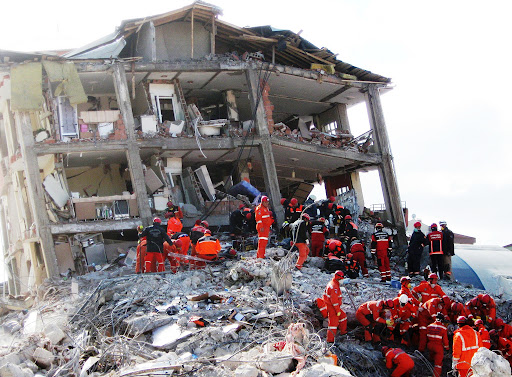
https://www.flickr.com/photos/eu_echo/6773874206/in/photostream
International aid is crucial to rescuing and supporting victims of a high magnitude earthquake. (Turkey Earthquake – a glimpse of the ECHO assessment, EU Civil Protection and Humanitarian Aid)
The Devastating Aftermath of Turkey-Syria Earthquakes
Earthquakes that hit already struggling areas of Turkey and Syria left millions injured, homeless, and searching for their loved ones amidst the rubble.
Death counts continue to rise after a 7.8 magnitude earthquake hit Turkey and Syria on February 6. The disaster was the largest earthquake to hit the area in decades, leaving thousands dead, and many more injured. A second earthquake, recorded at a magnitude of 6.8, hit Turkey on February 20, killing at least six. Relief efforts have been ongoing over the last few weeks, but many critique how the two countries have handled the situation.
The first earthquake hit near the densely populated city of Gaziantep in Turkey, followed by a series of severe aftershocks throughout the country. The bordering country of Syria was also hit, including Syria’s second largest city, Aleppo. Although earthquakes are not uncommon in the region, the location of the earthquake makes it “the worst natural disaster in the WHO European Region for a century,” according to the World Health Organization.
The World Health Organization reports that due to the disasters, around 26 million people are in need of humanitarian aid between both Turkey and Syria. The large majority of these victims are refugees who settled in cities along the Syria-Turkey border due to an ongoing civil war in Syria. According to the UN, Turkey has become home to around 3.7 million Syrian refugees in the past decade. Many of which live in communities that have suffered from a poverty crisis for years, leaving them without resources to address the earthquake’s damage.
One reason the death toll in Turkey is so high is due to the thousands of buildings that have collapsed because of the earthquake. Critics blame the government of Turkey for turning a blind eye against buildings in the area that they knew did not meet regulations.
David Wald, a scientist with the United States Geological Survey explained, “It’s difficult to watch this tragedy unfold, especially since we’ve known for a long time that the buildings in the region were not designed to withstand earthquakes… many structures in this region are particularly vulnerable.”
With millions of people injured and even more displaced, international aid has been essential to helping as many civilians as possible. Rescue workers are still pulling people out of the rubble, as well as delivering food and emergency shelter to those who have lost their homes.
On February 15, the UN announced they would be spending one billion dollars on humanitarian agencies to assist more than five million people in Turkey. Other international services have spent millions on providing medical aid to people rescued from the wreckage.
However, international help has not been as well received in Syria. The economic and political crisis in Syria have only amplified the damage caused by the earthquake. Not only has collapsed roads blocked emergency resources from reaching the cities, but the Syrian government and rebel groups controlling parts of Syria have blocked many rescue teams from reaching the destroyed areas.
Following the most recent earthquake, fear among millions of Turkish and Syrian civilians continues to rise as more homes crumble to the ground.
